| Rye %: | 65% |
| Stages: | Sponge, final dough |
| Leaven: | Sour culture, yeast |
| Start to Finish: | 14-16 hours |
| Hands-on Time: | 30-40 minutes |
| Yield: | One 4 lb. (1.8 kg.) loaf |
I find myself drawn to heavy, rustic rye breads, and this one, which I adapted from the formula of a north German baker named Albert Schäfer, really lives up to its name. This is a coarse, chewy, quintessenial rye bread with a moist and tender crumb, great mouth feel – thanks to the seeds and coarse rye meal – and an intensely tangy finish that provides a lovely counterpoint to the sweetness of the spelt or wheat.
Technically, this recipe is interesting because it doesn’t call for a bulk ferment; instead, the dough goes directly into a parchment-lined loaf pan and proofs at 100°F/41°C for just one hour. Also, unlike the vast majority of rye breads I’ve baked, this one neither uses steam nor calls for temperature adjustments during the bake, but bakes at a steady 395°F/200°C for nearly two hours.
In all, it’s a simple, straightforward and very rewarding loaf: Filling. Tasty. Great with strong cheeses and smoked fish and meats.
Sponge (Day 1, Evening):
| Ingredient | Grams | Ounces | Baker’s Percentage |
| Medium rye flour |
280 |
9.90 |
100% |
| Water |
280 |
9.90 |
100% |
| Rye sour |
40 |
1.40 |
14% |
Combine the sponge ingredients in the bowl of a stand mixer, cover and ferment at room temp (70°F/21°C) 10-12 hours or overnight.
The sponge will have doubled in volume and show cracks on the surface.
Final Dough (Day 2, Morning):
| Ingredient | Grams | Ounces |
| Warm (110°F/43°C) water |
240 |
8.45 |
| Fresh yeast |
13 |
0.45 |
| Coarse rye meal |
240 |
8.45 |
| Whole spelt or wheat flour |
280 |
9.90 |
| Sunflower seeds |
15 |
0.55 |
| Pumpkin seeds |
10 |
0.35 |
| Sesame seed |
10 |
0.35 |
| Flaxseed |
10 |
0.35 |
| Salt |
15 |
0.55 |
| Rolled oats for topping |
As needed |
|
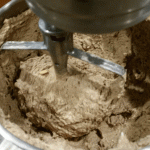 Add the yeast and water to the sponge, then use the paddle at low (KA 2) speed to mix until evenly blended, 2-3 minutes. Continue mixing while gradually adding the rye meal, spelt or wheat flour, seeds, and salt until the dough comes together in a sticky, homogeneous mass, 6-8 minutes.
Add the yeast and water to the sponge, then use the paddle at low (KA 2) speed to mix until evenly blended, 2-3 minutes. Continue mixing while gradually adding the rye meal, spelt or wheat flour, seeds, and salt until the dough comes together in a sticky, homogeneous mass, 6-8 minutes.
Use a wet bowl scraper to transfer the dough into a 9″x4″x4″/23 x 10 x 10 cm Pullman loaf pan or standard 9″ x 5″ x 3½” loaf pan lined with greased parchment. Use wet hands to pack the dough down and smooth the top crust.
Brush the loaf with water, sprinkle generously with rolled oats, cover with plastic wrap and proof in a 100°F/41°C oven until the dough reaches the rim of the pan, about 1 hour.
Remove the plastic wrap, raise the oven temperature to 395°F/200°C and bake until the loaf thumps when tapped with a finger and the internal temp is at least 198°F/92°C, 1¾-2 hours. Unpan the loaf to a rack and immediately remove the parchment. Brush all sides of the loaf generously with boiling water and let stand for at least 24 hours before slicing.
Baker’s Percentages:
| Ingredient |
g |
% |
| TOTAL FLOUR |
800 |
100.00% |
| Rye flour |
280 |
35.00% |
| Spelt or wheat flour |
280 |
35.00% |
| Coarse rye meal |
240 |
30.00% |
| Water |
520 |
65.00% |
| Salt |
15 |
1.88% |
| Fresh yeast |
13 |
1.63% |
| Rye sour |
40 |
5.00% |
| Sunflower seeds |
15 |
1.88% |
| Sesame seed |
10 |
1.25% |
| Pumpkin seeds |
10 |
1.25% |
| Flaxseed |
10 |
1.25% |
| TOTAL FORMULA |
1,425 |
178.13% |
| Total dough prefermented |
280 |
35.00% |

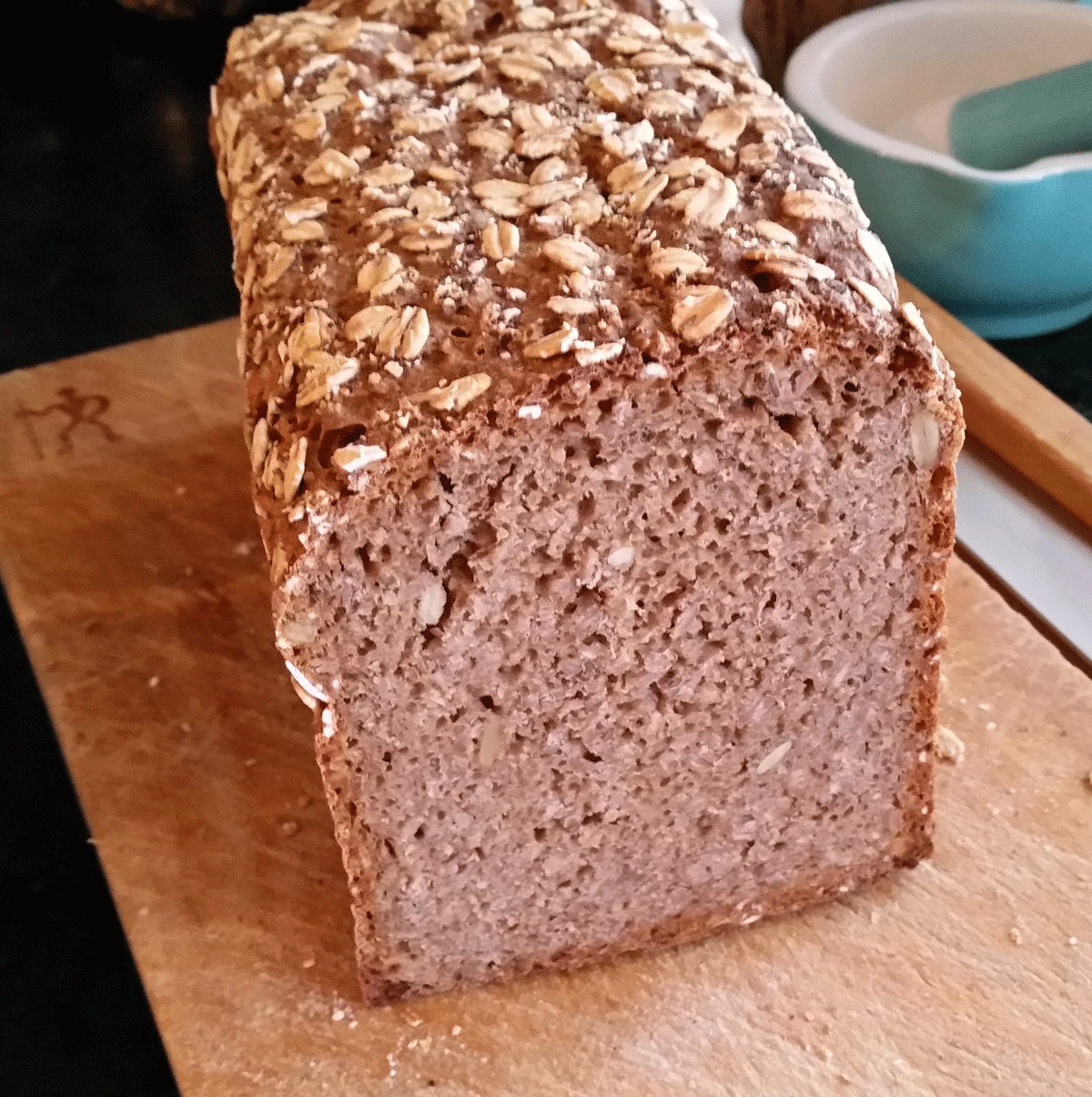

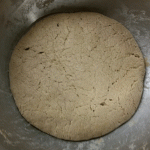
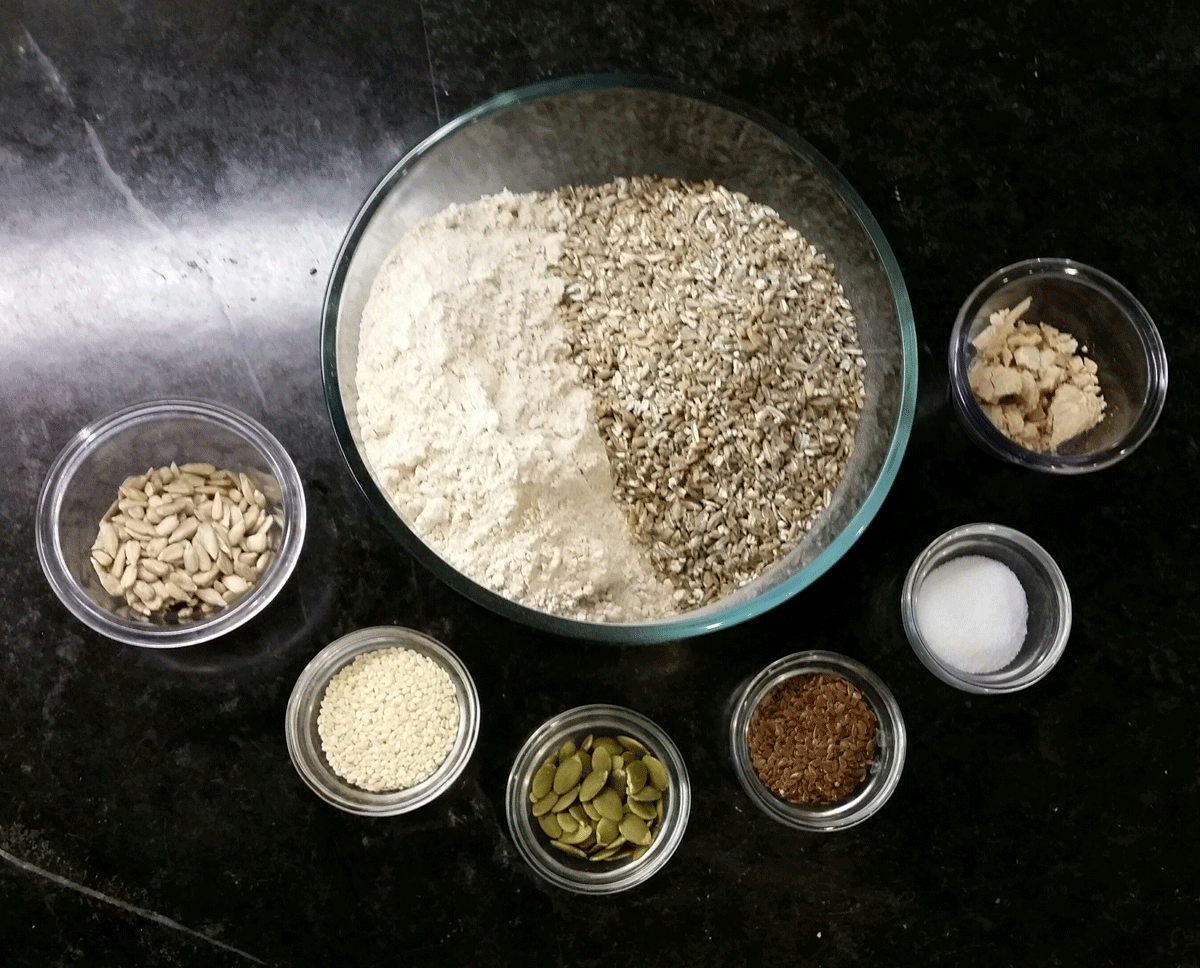
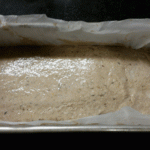
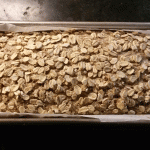

Justin
January 8, 2016When you say “rye sour”, what do you mean?
Stanley Ginsberg
January 8, 2016the rye seed culture.
Justin
January 9, 2016What’s in it – rye flour, water, and yeast I assume – but what percentage?
Brad
January 10, 2016Hi Stan. I’m so glad you started this blog. With your help, I am hoping to master high percentage rye breads. In your photo of the ingredients the coarse rye meal looks like some commercially available rye chops (specifically from Bob’s Red Mill). When I have used these, they tend to be as a soaker in my wheat breads and they sit overnight in water to soften. Since you don’t soak them, they must absorb a fair amount of water from the dough, so what effect does it have on the overall behavior of the dough? And if this is coarse rye meal, what exactly are chops?
I look forward to many more of your posts. Thanks.
Ballroom_billy
January 12, 2016Stan, I was wondering about the brushing the sides of the loaf with boiling water. I’ve never heard of that and was wondering about it’s purpose.
Thanks
Stanley Ginsberg
January 14, 2016It’s done to soften the crust, which, given rye’s relatively high baking temperatures, can become dentally challenging.
Karin Anderson
January 15, 2016Looks like a very nice bread, especially with all those tasty seeds (do you toast them before adding them?).
Fermenting it directly in the pan makes handling sticky, coarse dough much easier, no shaping needed, and this kind of bread is supposed to be dense, anyway.
Instead of brushing the hot loaf with water, you can also mist it with a sprayer bottle – faster and easier.
Is there a function on this website to notify users of other comments?
Promise
February 15, 2016I have just been bitten by the bread baking bug. I hope to one day turn out a loaf as lovely as this one! Looks so delicious!
Karen
September 8, 2017I am trying these rye breads of late but have a very hard time with grams etc. Do you make this available in US measures? I thought I would ask as there is only a yes or no that came come. Yes, I will be happier though 🙂 Thank you.
Stanley Ginsberg
September 8, 2017The recipes also include weights in ounces. I don’t use volume measurements (cups, spoons) because they aren’t precise: depending on how compacted flour is, one cup could weigh anywhere between 4 and 6 ounces, and a tablespoon of kosher salt, depending on the brand, can weigh anywhere from 3/8 to 5/8 of an ounce.
Robert Blomberg
July 26, 2018I made this bread the other day and I thought I really screwed it up because the dough was so moist when I started the baking process. It seemed to me it was almost like pancake batter, slightly thicker. The bread turned out wonderful, between my wife and I we ate half the loaf the first day. I used spelt instead of whole wheat in the recipe. The only question I have is why wait the 24 hours to eat it? Is that so it dry’s out a little? Thanks for the Recipe it is great.